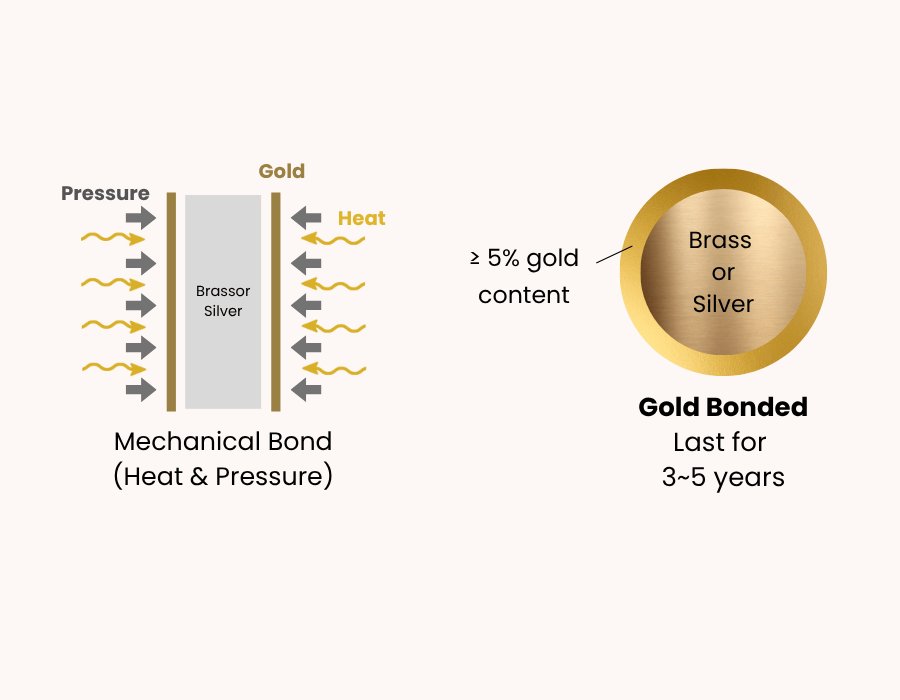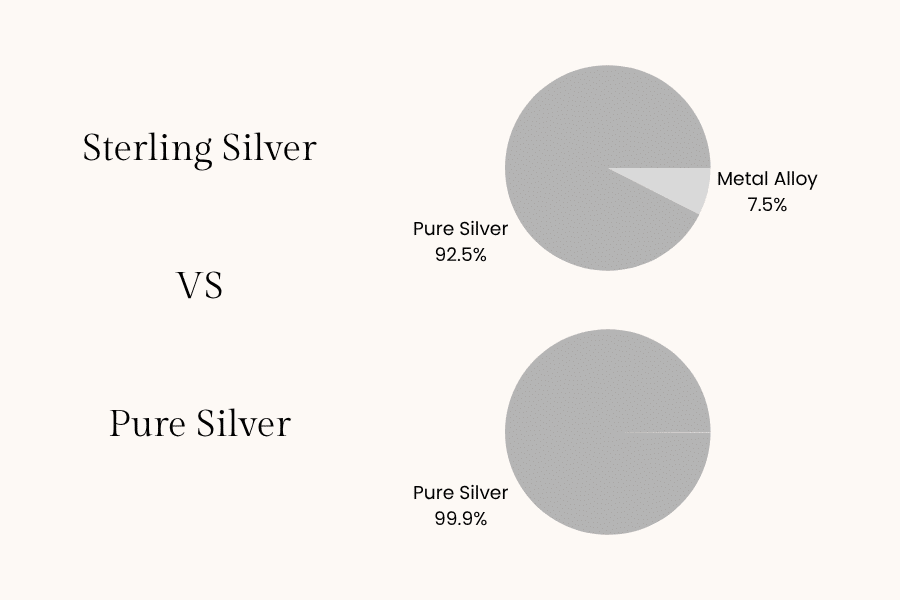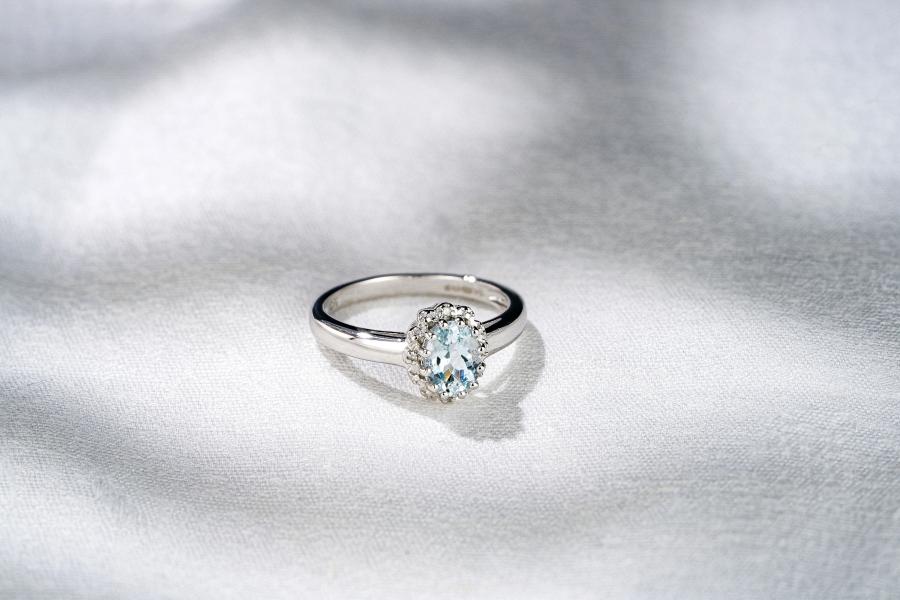Does every gold piece inevitably tarnish? No!
This guide will explore the causes of gold tarnishing, prevention methods, and the best tarnish-free gold jewelry options. But before we dive in, let’s take a quick look at some common types of gold jewelry.
Common Gold Jewelry Types
Gold jewelry comes in different types, and being able to differentiate them can help you assess their quality and durability. Here are five common gold jewelry types:
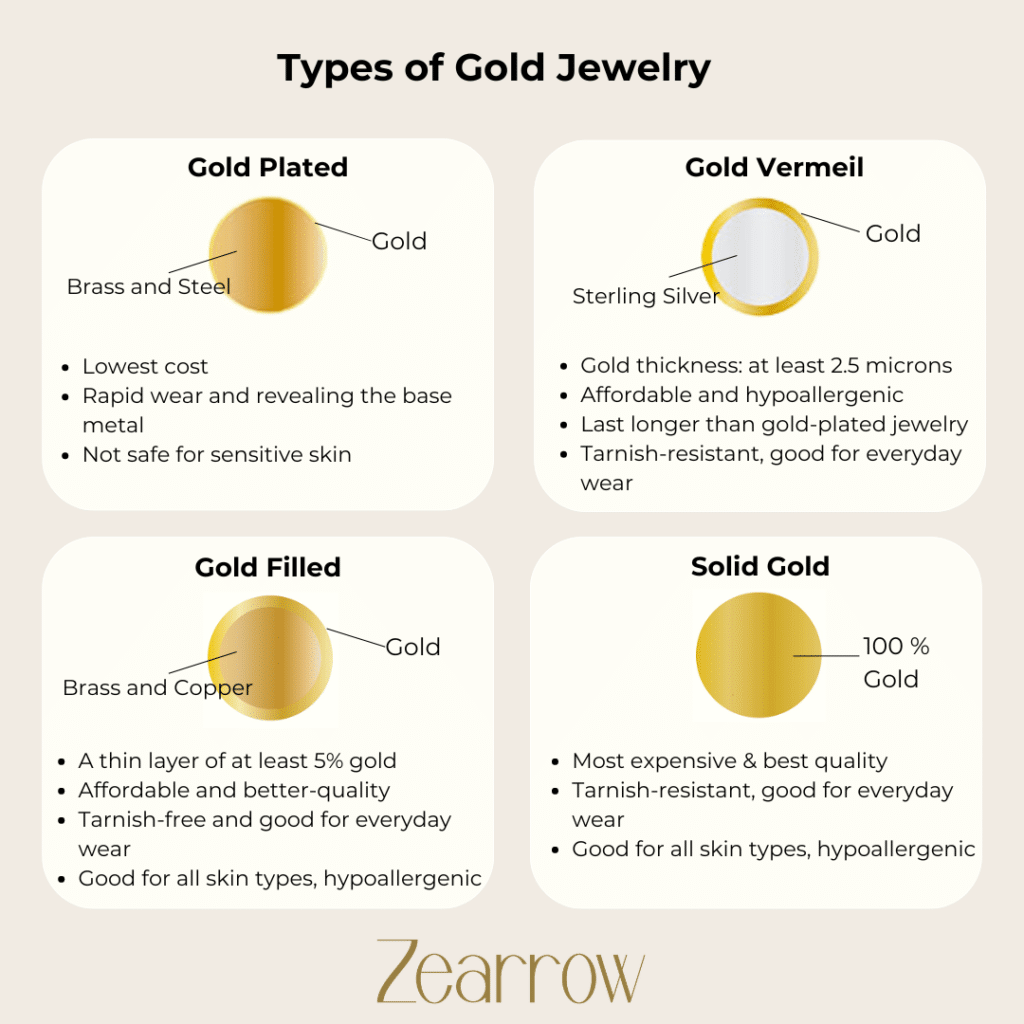
Gold Plated on Brass/Silver Jewelry
Standard gold plating on brass jewelry gives a thin layer of gold on the jewelry. The thickness ranges from 0.03 to 0.5 microns. However, the thin gold layer tends to wear off quickly (color retention from 6 to 12 months) due to constant use and exposure to sunlight or chemicals, which impacts the jewelry’s luster and shine.
Gold Vermeil Jewelry
Unlike gold-plated jewelry which involves bonding a thin layer of gold to the base metal, gold vermeil jewelry involves bonding a thicker layer of gold. The amount of applied gold differs depending on the country’s standard. For example, while the United States regulations require at least 2.5 microns of gold thickness, Canada requires only 1.0 microns.
Gold vermeil is hypoallergenic, making it suitable for people with metal allergies to wear safely. And it doesn’t fade quickly since the gold plating is thicker.
Gold Filled Jewelry
Gold-filled jewelry is made by permanently binding a thick sheet of gold to a base metal (brass/copper). It contains almost 100 times more gold than gold-plated jewelry. The thick sheet of gold makes up at least 5% of the jewelry’s total weight, making it impossible to peel off easily.
Solid Gold Jewelry: from 9K gold to 24K gold
Solid gold jewelry is pure gold with no base metal. However, pure gold (24k) is too soft to shape into jewelry, so it is mixed with other metals to give it strength and durability. There are different karats of gold, ranging from 9K to 24K. The higher the karat, the higher the percentage of pure gold in the jewelry.
PVD Gold on Stainless Steel Jewelry
PVD gold on stainless steel jewelry is a tarnish-free gold jewelry created through the Physical Vapor Deposition (PVD) process. PVD plating is a new technology that uses a vacuum to vaporize a thin layer of gold and bond it to stainless steel. This process creates a high-quality finish, making the piece more durable and resistant to wear and tear.
Why Does Jewelry Tarnish?
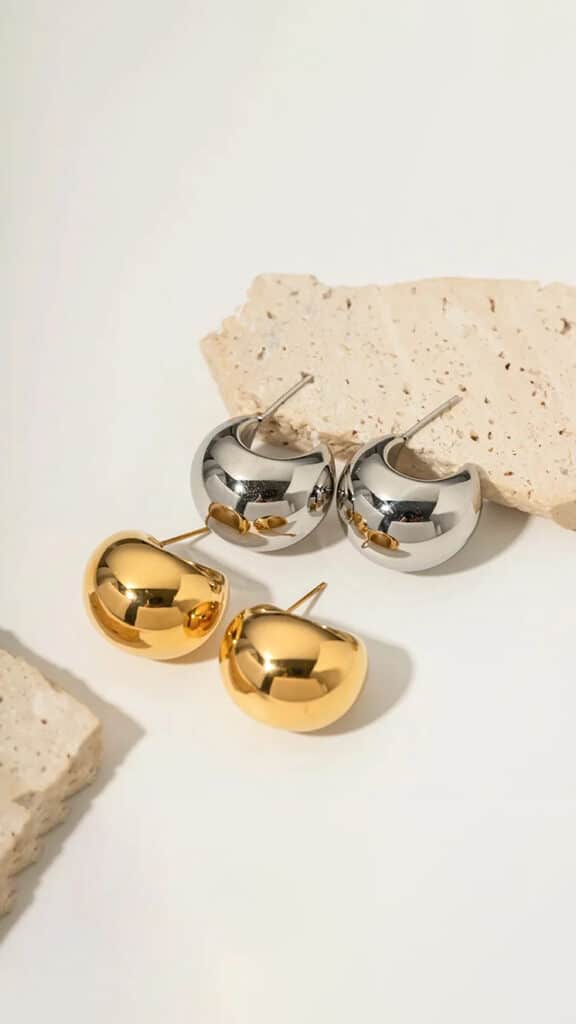
Gold jewelry can tarnish due to several factors, especially exposure to air, sweat, makeup, and other chemical elements. Here are five major factors that cause gold jewelry to tarnish:
Alloy Metal
Most pieces of gold jewelry are an alloy; that is, they are mixed with other metals (nickel/copper/silver). While these metals provide strength and durability, they can tarnish when exposed to air, water, sweat, or harsh chemicals, resulting in a dull or discolored appearance.
Air
Oxygen plays a significant role in the tarnishing process of gold jewelry. For instance, exposing a gold vermeil jewelry piece to the air (humid or polluted environment) for a long time can lead to oxidation. This reaction causes changes in the chemical composition of the base, resulting in tarnish or rust.
Water
Water in its pure form cannot cause tarnish, but when it contains elements like chlorine, it can cause tarnishing. For instance, if you don’t remove your gold jewelry before entering the pool, it will likely tarnish because of the high chlorine level in swimming pools.
Sweat
Human sweat contains acid and other harsh chemicals that cause tarnishing, especially if the piece is not regularly cleaned. If you sweat a lot, your gold jewelry is prone to tarnishing.
Chemicals
House products, such as cleaning agents, detergents, perfumes, lotions, and cosmetics, can cause tarnishing. These items contain chemical substances that can cause gold jewelry (especially gold-plated) to tarnish when they come directly in contact with them.
Common Types of Tarnish
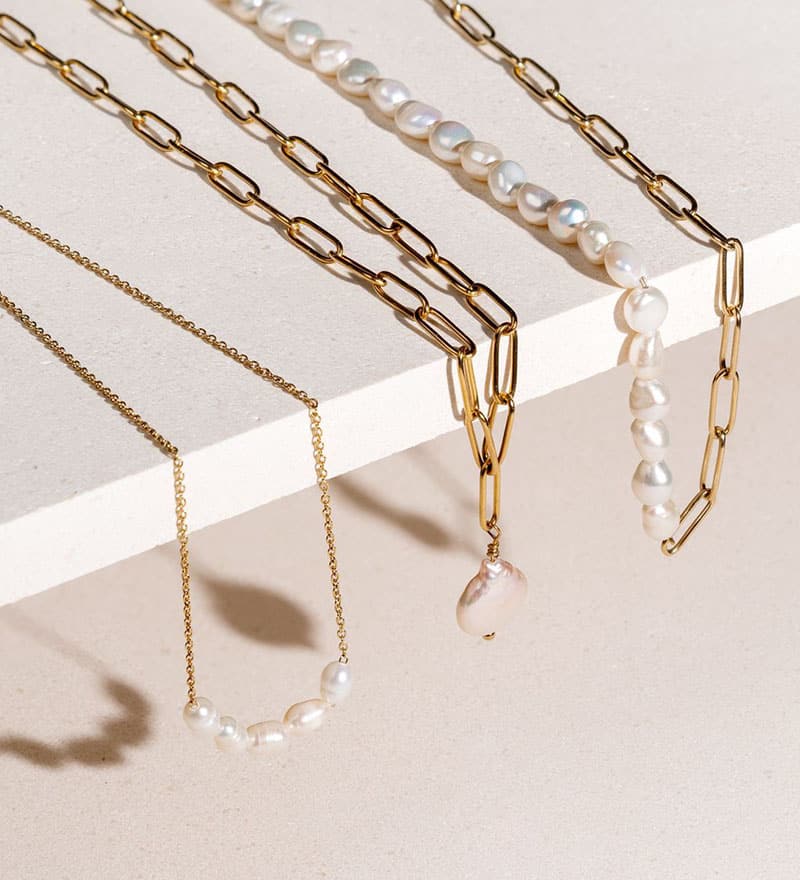
Jewelry can lose its luster and beauty over time due to various forms of tarnishing. Here are the common types of jewelry tarnishing and what causes them:
Scratches
Scratches are surface abrasions that occur when jewelry comes into contact with harder materials. These can dull the appearance of metals and diminish their shine.
Turning Black/Green/Yellow
Jewelry, especially those made from sterling silver and copper, can turn black when exposed to air and moisture due to a chemical reaction called oxidation.
When jewelry made of metals like copper or brass reacts with oxygen, moisture, or acids, it can turn green.
Gold jewelry can sometimes develop a yellowish hue due to tarnishing. This is especially common with lower karat gold that contains higher amounts of alloy metals like copper or silver. These metals can oxidize over time, leading to discoloration。
What Does Tarnish-Free Gold Jewelry Mean?
Tarnish-free gold jewelry is defined by specific properties, such as anti-scratch, waterproof, sweat-resistant, sunscreen-resistant, and skincare-resistant. They are usually designed with high-quality gold alloys or treated with a protective coating to resist tarnishing and maintain their original appearance over time.
Non-tarnish gold jewelry is usually more expensive than traditional gold jewelry, but its longevity and ease of maintenance make it a cost-effective choice. Thankfully, there are many cheap non-tarnish gold jewelry options like the PVD gold plated jewelry, which is less expensive than solid gold.
What Gold Jewelry Doesn’t Tarnish Easily?

The three major types of gold jewelry that won’t tarnish easily are:
Solid Gold 14K & above
Solid gold (14K and above) is your best bet if you seek non-tarnishing gold jewelry. Anything lower than 14K is usually at risk for tarnishing because of the more significant percentage of other metals (which are prone to tarnish.)
Gold filled
The thick layer of gold present in gold-filled jewelry makes it more durable and highly resistant to tarnishing. Gold-filled jewelry will last longer and maintain its shine if maintained properly.
PVD Gold Plated Jewelry
The vacuum process through which PVD gold-plated jewelry undergoes makes it highly tarnish-resistant. It improves the jewelry’s aesthetics, toughness, and resistance to wear, corrosion, and tarnishing.
Which Jewelry Material Does Not Tarnish?
So, what metal doesn’t tarnish? Opt for the following materials if you are looking for non-tarnish jewelry.
Stainless Steel
Stainless steel is known for its high resistance to tarnishing and corrosion. 316L stainless steel, a medical-grade material, is highly recommended for its superior hypoallergenic and corrosion resistance.
Pure gold
Only 24K solid gold jewelry is 100% tarnish-free. Gold-filled jewelry and PVD gold jewelry are highly tarnish-resistant, while gold-plated and gold vermeil jewelry are more prone to tarnish.
Palladium
Palladium is usually added to make the jewelry stronger and harder. It is an ideal jewelry metal since it won’t tarnish. Unlike other jewelry metals, it doesn’t need rhodium plating or frequent polishing to maintain its luster.
Does Gold-Plated Jewelry Tarnish?
Yes, gold-plated jewelry is not completely tarnish-free and it will tarnish over time. However, the speed and extent of tarnishing depend on the gold layer’s thickness and its exposure to air, water, and other chemicals.
Does Gold Vermeil Jewelry Tarnish?
Some gold vermeil jewelry may be tarnished, but higher grades of gold vermeil jewelry are non-tarnishing. 14K and above is recommended.
Does 14K Gold Tarnish?
14K and above solid gold is the kind of gold jewelry that doesn’t tarnish easily. It is much more tarnish-resistant than gold plated, but it will tarnish over time.
Does 18K Gold Tarnish?
18K solid gold is tarnish-resistant. However, it is a bit softer and less durable when compared to 14K gold because of the lesser content of alloyed metals in it.
What Gold Jewelry Can I Wear in The Pool?
Solid gold and gold-filled jewelry can be worn while swimming. However, they might discolor due to chlorine exposure. Among all options, solid gold is considered the most reliable choice for waterproof gold jewelry.
What Gold Jewelry Can I Wear in The Shower?
Solid gold (14K and above), gold-filled jewelry, and PVD gold jewelry. They are waterproof and highly resistant to bathing solutions like shampoo, soap, etc.
Best Tarnish-Free Gold Jewelry
Generally, the best non tarnish gold jewelry types are solid gold and gold-filled.
- Solid gold jewelry of high gold proportions (14K and above) is less prone to tarnishing due to the higher quantity of pure gold, retaining its beauty and allure over time.
- Gold-filled jewelry is mechanically or chemically 5% gold content bonded to a base metal, making it highly resistant to chemicals and water, and less likely to tarnish.
Affordable Anti-Tarnish Gold Jewelry
We recommend PVD gold-plated stainless steel jewelry as a cost-effective choice. It’s a great option for those seeking inexpensive gold jewelry that won’t tarnish, thanks to its durable protective coating that also mimics the appearance of solid gold.
How to Prevent Jewelry From Tarnishing?
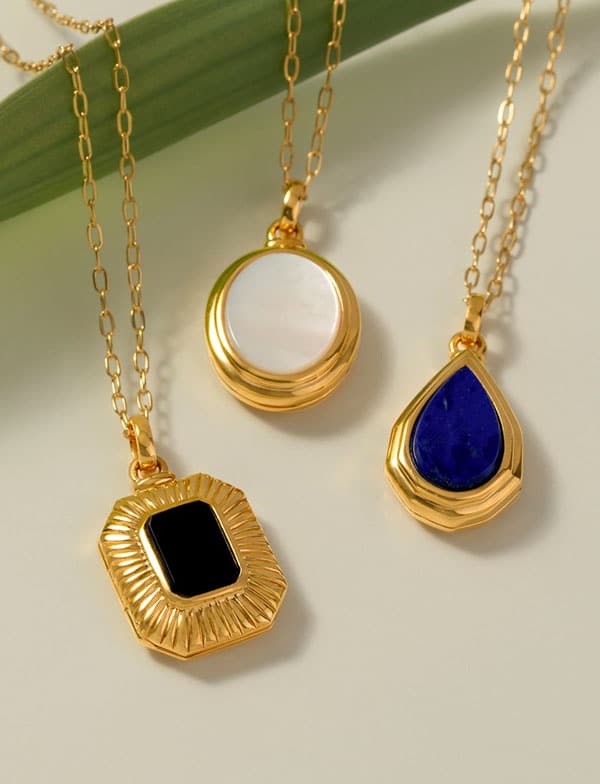
While gold jewelry can tarnish, there are ways to minimize this effect. Here’s how to prevent jewelry from tarnishing:
- Minimize Contact with Water
Take off your gold jewelry before swimming, exercise, laundry, dishwashing, or other activities that can expose it to moisture. Also, dry your hands after washing to avoid sprinkling water on your jewelry.
- Store Your Jewelry Properly
It may be tempting to display our jewelry, but it increases its chances of tarnishing. Keep your jewelry in a dry and dark place, preferably in jewelry boxes or airtight plastic bags, to prevent them from moisture and air.
- Regular Cleaning with a Gentle Cloth
Regularly clean your jewelry with a soft, lint-free microfiber cloth or a jewelry polishing cloth to remove dirt, sweat, and oil that can cause tarnishing.
- Avoid Chemicals
Be mindful of perfume, lotions, cosmetics, and other chemical substances that can cause tarnishing. Also, don’t clean your jewelry with harmful chemicals. Consider contacting a custom jewelry manufacturer for a waterproof and anti-tarnish solution to preserve your gold for a long time.
Tips to Identify It Is a Tarnish-Free Jewelry Before Your Purchase
Differentiating a piece of non-tarnish jewelry is challenging. However, here are things to look out for:
- Check for marks
Jewelry “P” stamps are short for plumb, a term in the jewelry industry that means the product is solid gold. Solid gold 14k and above is tarnish-free. Meanwhile, look for GF jewelry marks (short for gold-filled). This mark indicates a much thicker layer of gold bonded over a base metal, making it more durable and resistant to tarnishing.
- Read the label
Gold pieces 14k and above are tarnish-resistant, and will typically maintain their shine and rich color as long as they are properly cared for.
Key Takeaway
Non-tarnish gold jewelry is a wise investment for jewelry lovers who want to experience the luster and brilliance of gold for a long time. Solid gold and gold-filled are the best tarnish-free gold jewelry types. Contact us today to get your pieces that continue to sparkle and dazzle for years.

